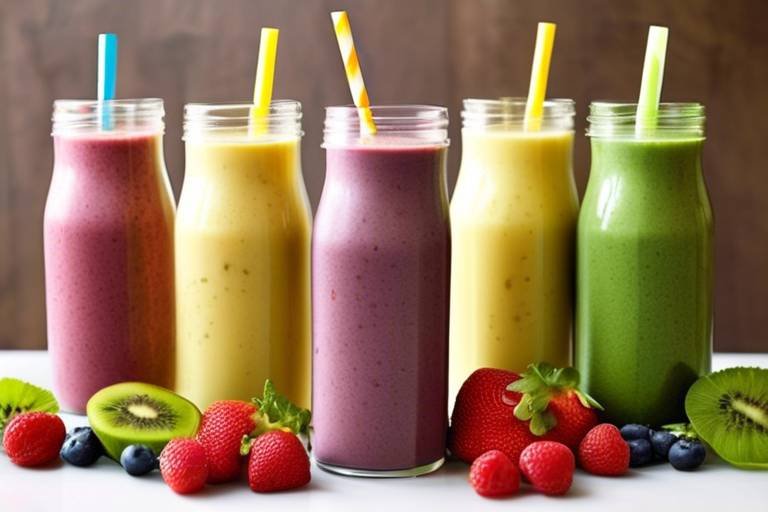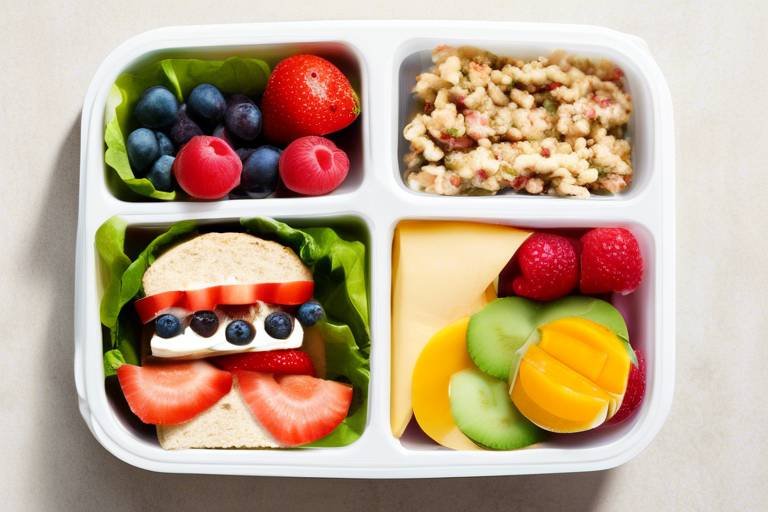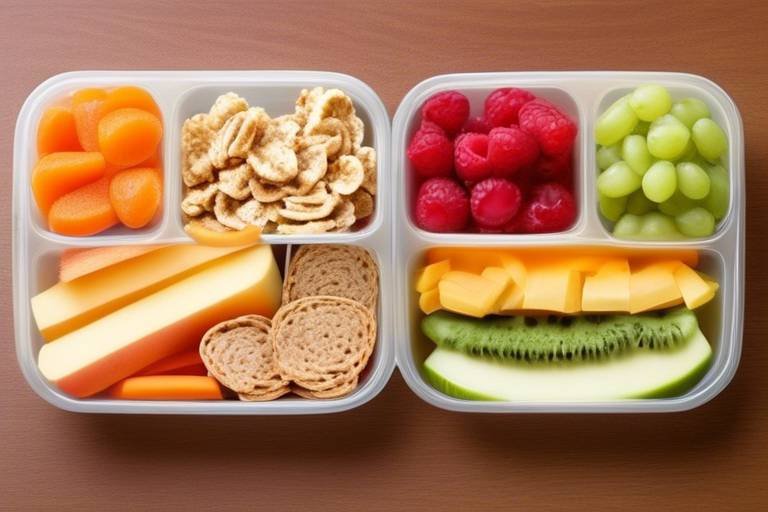Beating the Sweets: A Guide to Lowering Sugar in Your Child's Diet
As parents, we all want the best for our children, and that includes their health. One of the most pressing concerns in today's world is the alarming amount of sugar that sneaks into our kids' diets. Reducing sugar intake is crucial, not just to prevent obesity and diabetes, but to foster overall well-being and healthy habits that can last a lifetime. So, how do we tackle this sweet menace? Let's dive into the importance of lowering sugar and explore some effective strategies to help your child thrive.
Understanding why lowering sugar is crucial for children's health can motivate parents to make dietary changes. Excessive sugar intake can lead to obesity, diabetes, and other health issues in children. Research shows that children who consume high amounts of sugar are at a greater risk for developing chronic health conditions later in life. This is not just a passing trend; it’s a wake-up call for parents everywhere. By reducing sugar, we are not only protecting our children’s health but also setting them on a path towards a healthier future.
Many processed foods contain hidden sugars that can be overlooked. Learning to read labels and identify these sugars is essential for making healthier food choices for your child. You might be surprised to find out how many everyday items are loaded with sugar. From sauces to cereals, hidden sugars can easily sneak into your child's meals without you even realizing it.
Familiarizing yourself with common food items that contain hidden sugars helps in making informed decisions. Here are some typical culprits:
- Condiments: Ketchup, BBQ sauce, and salad dressings can contain significant amounts of sugar.
- Cereals: Many breakfast cereals marketed to kids are often high in sugar.
- Snacks: Granola bars, yogurt, and even fruit snacks can have added sugars.
Understanding how to read nutrition labels can empower parents to spot hidden sugars effectively. Look for terms like sucrose, fructose, and corn syrup to identify added sugars. If you see these ingredients listed early in the ingredient list, it's a red flag that the product is high in sugar. Remember, knowledge is power, and being informed can help you make better choices for your child's diet.
Becoming savvy about ingredient lists can help you avoid products loaded with sugar. Ingredients are listed by quantity, so those appearing first are often the most prevalent. If sugar is one of the first few ingredients, it's a clear indication that the product is not the healthiest option. Always compare products and choose those with lower sugar content.
Replacing sugary snacks with healthier options can significantly reduce sugar intake. Introducing fruits, nuts, and yogurt as alternatives encourages better eating habits for your child. For instance, instead of reaching for a candy bar, consider offering a piece of fresh fruit or a handful of nuts. Not only are these options healthier, but they also provide essential nutrients that sugary snacks lack.
Implementing practical strategies at home can ease the transition to a lower-sugar diet. Simple changes in meal planning and snacking can make a big difference in your child’s sugar consumption. Here are some tips to help you get started:
Getting children involved in meal preparation can foster a sense of ownership over their food choices. This engagement can lead to more enthusiasm for healthy eating. When kids help in the kitchen, they are more likely to try new foods and appreciate the effort that goes into making healthy meals. Plus, it’s a fun way to spend quality time together!
Ensuring that healthy snacks are readily available can reduce the temptation for sugary options. Stocking up on fruits, vegetables, and whole grains promotes better snacking habits. Consider setting up a designated snack area in your kitchen filled with healthy options. When kids are hungry, they will reach for what’s easily available, so make sure those choices are nutritious!
Q: How can I make healthy snacks more appealing to my child?
A: You can make healthy snacks more appealing by involving your child in the selection process, presenting snacks in fun shapes, or pairing them with healthy dips like yogurt or hummus.
Q: Is it okay to let my child have sweets occasionally?
A: Yes, moderation is key! Allowing occasional treats can help your child learn about balance and make healthier choices in the long run.Q: What are some good alternatives to sugary drinks?
A: Water, herbal teas, and flavored sparkling water are excellent alternatives to sugary drinks. You can also infuse water with fruits for a refreshing twist.

The Importance of Reducing Sugar
Understanding why lowering sugar is crucial for children's health can motivate parents to make dietary changes. Excessive sugar intake can lead to a myriad of health issues, including obesity, diabetes, and even heart disease. Imagine your child as a car; when fueled with high-octane sugar, they may zoom around for a bit, but eventually, that fuel will cause breakdowns and malfunctions. The same goes for their bodies. Too much sugar can lead to energy crashes, mood swings, and even behavioral issues. It’s not just about the occasional candy bar; it’s about the cumulative effect of sugar in their daily diets.
Moreover, studies have shown that children who consume high amounts of sugar are more likely to develop chronic health problems as they grow older. This isn't just a fleeting concern; it’s a long-term investment in their health. By reducing sugar intake, you’re not only helping them maintain a healthy weight but also setting them up for a lifetime of better health choices. Think of it as planting seeds for a flourishing garden. The less sugar they consume now, the more likely they are to grow into healthy, vibrant adults.
To put it simply, reducing sugar is not just a trend; it’s a necessity. The World Health Organization recommends that children should limit their intake of free sugars to less than 10% of their total energy intake. For a child consuming about 1,500 calories a day, that’s less than 37.5 grams of sugar! That might sound like a lot, but when you consider that a single can of soda can contain over 30 grams, it quickly becomes clear how easy it is to exceed this recommendation.
In addition to the physical health implications, there's also a psychological aspect to consider. Children who consume high amounts of sugar may develop a preference for sweet foods, making it harder to introduce them to healthier options later on. This can create a cycle of unhealthy eating habits that are hard to break. The earlier you can instill healthy eating habits, the better equipped your child will be to make wise food choices as they grow.
In conclusion, reducing sugar in your child's diet is not just about cutting out sweets; it's about nurturing their overall health and well-being. By taking proactive steps to limit sugar intake, you're empowering them to lead healthier, happier lives. So, let’s roll up our sleeves and dive into practical strategies for making this change together!
- What are some signs that my child is consuming too much sugar? Look for symptoms like hyperactivity, frequent mood swings, and fatigue after sugar crashes.
- How can I replace sugary snacks effectively? Consider fruits, yogurt, or nuts as healthier alternatives that still satisfy sweet cravings.
- Are all sugars bad? Not all sugars are created equal. Natural sugars found in fruits and dairy are generally healthier than added sugars in processed foods.

Identifying Hidden Sugars
When it comes to your child's diet, being vigilant about hidden sugars is crucial. You might be surprised to learn that many foods marketed as "healthy" can be loaded with added sugars that slip under the radar. These sneaky sugars can contribute to health problems, including obesity and diabetes, making it essential for parents to become sugar detectives in their own kitchens. But how do you identify these hidden sugars? Let’s dive into the world of food labels and ingredient lists.
First off, it’s important to understand that sugar can masquerade under various names. When you’re shopping, you need to be on the lookout for terms like sucrose, fructose, corn syrup, and high-fructose corn syrup. These are just a few of the many aliases that sugar can take on, and they can be lurking in everything from sauces to cereals. For example, a seemingly innocent bottle of pasta sauce might contain more sugar than you’d expect, which can add up quickly when combined with other meals throughout the day.
To make things easier, here’s a quick reference table to help you identify common sources of hidden sugars:
| Food Item | Potential Hidden Sugars |
|---|---|
| Breakfast Cereals | High-fructose corn syrup, honey, malt extract |
| Fruit Juices | Concentrated fruit juice, cane sugar |
| Sauces (like ketchup) | High-fructose corn syrup, cane sugar |
| Snack Bars | Brown rice syrup, agave nectar |
Another vital step in your sugar detective journey is learning how to read nutrition labels effectively. The Nutrition Facts label on food packaging provides a wealth of information, including the amount of sugar per serving. However, don’t stop there—always check the ingredient list as well. Ingredients are listed in descending order by quantity, meaning the first few ingredients are the most prevalent. If sugar is one of the first few ingredients, it’s a clear sign that the product is loaded with it.
For instance, a popular snack might list “whole grain oats” as the first ingredient, but if “sugar” or “corn syrup” follows closely behind, it’s a red flag. The goal is to choose products where whole foods like fruits, vegetables, and grains are the primary ingredients, minimizing the presence of added sugars.
By becoming savvy about reading labels and ingredient lists, you empower yourself to make informed decisions that benefit your child's health. Remember, knowledge is power! The more you know about hidden sugars, the better equipped you are to help your child develop healthier eating habits.
- What are some common hidden sugars to watch out for? Look for ingredients like sucrose, high-fructose corn syrup, and honey in processed foods.
- How can I encourage my child to eat less sugar? Involve them in meal prep and offer healthy snacks that are naturally sweet, like fruits.
- Are all sugars bad? Not all sugars are created equal; natural sugars found in fruits and vegetables come with beneficial nutrients.

Common Sources of Hidden Sugars
When it comes to reducing sugar in your child's diet, one of the biggest challenges is identifying hidden sugars lurking in everyday foods. Many parents are surprised to learn that sugar isn't just found in candy and desserts; it's often hidden in items they might consider healthy. For instance, did you know that certain breakfast cereals can contain more sugar than a chocolate bar? It’s crucial to be aware of these common sources to help make informed choices.
Let’s take a closer look at some of the most common culprits:
- Condiments: Ketchup, barbecue sauce, and salad dressings often contain significant amounts of added sugars to enhance flavor. A tablespoon of ketchup can have as much as 4 grams of sugar!
- Yogurts: Many flavored yogurts are marketed as healthy options but can be loaded with sugar. A single serving can contain anywhere from 10 to 20 grams of sugar, which is quite a lot for a snack.
- Snacks: Granola bars, fruit snacks, and even some protein bars can be deceptive. They may seem nutritious, but they often have high sugar content, making them more like candy than a healthy snack.
- Beverages: Fruit juices and smoothies may appear to be healthy choices, but they can be packed with sugar. A typical glass of fruit juice can contain as much sugar as a soda!
Understanding these sources is just the beginning. It’s essential to become a savvy shopper and read labels diligently. For example, a product marketed as "low-fat" might compensate for the loss of flavor with added sugars. The next time you're at the grocery store, make it a habit to check the nutrition labels and ingredient lists. Look out for terms like sucrose, high fructose corn syrup, and dextrose, which are all indicators of added sugars.
By becoming aware of these hidden sugars, you can take proactive steps to ensure your child’s diet is healthier. It's all about making informed decisions and choosing products that truly support their well-being. Remember, knowledge is power in the fight against sugar overload!
Q: How can I tell if a product has added sugars?
A: Always check the nutrition label for the "Total Sugars" and "Added Sugars" sections. Look for ingredients that end in "ose" or include syrup.
Q: Are all sugars bad for children?
A: Not necessarily. Natural sugars found in fruits and vegetables are generally healthier than added sugars found in processed foods.
Q: What are some healthy snacks to replace sugary options?
A: Consider offering fruits, nuts, yogurt (plain or low-sugar), and whole-grain crackers as healthier alternatives.

Reading Nutrition Labels
Understanding how to read nutrition labels is like unlocking a treasure chest of information that can significantly impact your child's health. When you dive into a nutrition label, you're not just looking at numbers; you're uncovering the secrets behind what’s really in the food you’re considering for your family. First and foremost, focus on the serving size. This is crucial because all the values listed, from calories to sugar content, are based on this specific amount. If your child eats more than the serving size, you need to adjust the numbers accordingly. For instance, if the label states that one serving has 10 grams of sugar and your child consumes two servings, that’s a whopping 20 grams of sugar!
Next, turn your attention to the total sugars section. This is where you can spot the total amount of sugar in the product, which includes both natural sugars (like those found in fruits) and added sugars. It’s essential to differentiate between these two because while natural sugars come with beneficial nutrients, added sugars can lead to health issues. Look for labels that highlight added sugars separately, as this will help you gauge how much extra sugar your child is consuming.
Another important aspect is the percent daily value (%DV). This percentage tells you how much a nutrient in a serving of food contributes to a daily diet based on a 2,000-calorie diet. For sugar, a %DV of 5% or less is considered low, while 20% or more is high. This can be a quick way to assess whether a product is a healthy choice or if it should be avoided.
Finally, be on the lookout for ingredient lists. Ingredients are listed in descending order by weight, so the first few ingredients are the most prevalent. If sugar or any of its many aliases—like sucrose, high fructose corn syrup, or agave nectar—appear at the top of the list, it’s a clear sign that the product is loaded with sugar. Familiarizing yourself with these terms can help you make better choices. Below is a table summarizing common sugar aliases to watch out for:
| Common Sugar Aliases |
|---|
| Sucrose |
| Fructose |
| Glucose |
| Corn syrup |
| High fructose corn syrup |
| Agave nectar |
| Honey |
By taking the time to familiarize yourself with nutrition labels, you empower yourself to make informed choices that can lead to healthier eating habits for your child. Remember, knowledge is power, and in this case, it can be the difference between a nutritious meal and a sugar-laden snack!

Ingredient Lists to Watch
When it comes to reducing sugar in your child's diet, being vigilant about ingredient lists is crucial. Many parents might be surprised to learn that some foods they consider healthy can be loaded with hidden sugars. The key is to understand that ingredients are listed in order of quantity, meaning the first few items on the list are the most prevalent. This is where you can uncover the sneaky sugars lurking in your child's favorite snacks and meals.
For instance, if you pick up a box of granola bars and see “sugar” or “high fructose corn syrup” listed among the top ingredients, it's a red flag. These are common culprits that can turn what seems like a wholesome snack into a sugar-laden treat. It’s essential to look beyond just the caloric content and focus on what’s actually in the food. Here are a few ingredient types to watch out for:
- Sucrose: This is table sugar, and it’s often added to many processed foods.
- Fructose: Found naturally in fruits, but when added in high amounts, it can be detrimental.
- Corn syrup: A sweetener derived from corn that can contribute to excessive sugar intake.
- Agave nectar: Marketed as a natural sweetener, but it can be just as sugary as traditional sweeteners.
In addition to these common ingredients, be on the lookout for any products that contain “syrup” or “nectar” in their names, as these often indicate added sugars. It's also worth noting that some products might use clever marketing terms like “natural sweeteners” or “no added sugar”, but still contain significant amounts of sugar in other forms. Always read the fine print!
To make it easier for you, consider creating a cheat sheet of common sugar aliases and their effects. This can be a handy reference when you’re shopping, ensuring you make informed decisions. Remember, knowledge is power! By being aware of what goes into your child's food, you can help steer them towards healthier eating habits.
Q: How can I tell if a product has added sugars?
A: Check the ingredient list for terms like sugar, corn syrup, fructose, and any other sweeteners. If these appear near the top of the list, the product likely contains significant added sugars.
Q: Are all sweeteners bad for my child?
A: Not all sweeteners are created equal. While natural sweeteners like honey and maple syrup can be healthier alternatives in moderation, it's crucial to limit overall sugar intake.
Q: What are some healthy snack options for kids?
A: Consider fresh fruits, unsweetened yogurt, nuts, and whole-grain crackers. These options provide essential nutrients without the excess sugar.

Choosing Healthy Alternatives
When it comes to reducing sugar in your child's diet, one of the most effective strategies is to replace sugary snacks with healthier alternatives. This doesn't mean you have to turn into a food tyrant overnight; instead, think of it as a fun adventure into the world of nutritious eating. By introducing a variety of delicious, natural options, you can make healthy eating exciting rather than a chore.
For instance, consider swapping out those sugary cereals that are often marketed to kids for something more wholesome. Whole grain cereals or oatmeal topped with fresh fruits can be a delightful breakfast that keeps their energy levels steady throughout the morning. Not only are these options lower in sugar, but they are also packed with fiber, which is essential for your child's growth and development.
Another fantastic alternative is to replace candy and cookies with fruits and nuts. Fruits like apples, bananas, and berries can satisfy that sweet tooth without the added sugars and empty calories. Nuts, on the other hand, provide healthy fats and proteins. You might even consider making a fun trail mix together—mixing nuts, seeds, and dried fruits can create a delightful snack that feels indulgent but is actually quite healthy.
Yogurt is another great option. Instead of flavored yogurts that are loaded with sugars, opt for plain yogurt and let your child add their own toppings. They can sprinkle in some fresh fruit or a drizzle of honey for sweetness. This not only allows them to control the amount of sugar they consume but also makes them feel involved in their food choices.
To help you visualize these alternatives, here’s a simple table comparing common sugary snacks with healthier choices:
| Sugary Snacks | Healthy Alternatives |
|---|---|
| Fruit-flavored candies | Fresh fruit slices |
| Chocolate bars | Dark chocolate (in moderation) |
| Store-bought cookies | Homemade oatmeal cookies with fruit |
| Ice cream | Frozen yogurt or banana ice cream |
Ultimately, the goal is to create a balanced diet that your child enjoys. Encourage them to explore different flavors and textures, and don't be afraid to get creative in the kitchen. Remember, it's not just about cutting out sugar; it's about fostering a love for healthy foods that can last a lifetime. By making these small changes, you're not only helping your child develop healthier eating habits but also setting them up for a future filled with vitality and well-being.
Q: How can I get my child to try new healthy foods?
A: Start by introducing one new food at a time alongside their favorite dishes. Make it fun by involving them in the cooking process and offering a variety of textures and flavors.
Q: What if my child refuses to eat fruits and vegetables?
A: Try different preparation methods, such as smoothies, dips, or baking. Sometimes, presenting food in a fun way can entice children to try them.
Q: Are natural sweeteners a good alternative?
A: Natural sweeteners like honey or maple syrup can be better options than refined sugars, but they should still be used in moderation. Always check with a pediatrician if you're unsure.

Practical Tips for Parents
When it comes to lowering sugar in your child's diet, it can feel like navigating a minefield. But fear not! With a few practical tips, you can make this journey not only manageable but also enjoyable for both you and your child. Start by involving your little ones in the meal preparation process. When kids help in the kitchen, they often develop a sense of ownership over their food choices. This means they are more likely to embrace healthier options. You might be surprised at how excited they get about washing vegetables or mixing up a batch of homemade granola!
Another effective strategy is to make healthy snacks easily accessible. Stock your pantry and fridge with a variety of nutritious options like fresh fruits, crunchy vegetables, and whole grain snacks. When kids come home from school or feel peckish, they should have a quick grab-and-go choice that doesn’t involve reaching for sugary treats. You could even create a colorful fruit bowl on the kitchen counter, or prepare snack bags filled with nuts and dried fruits. Not only does this promote better snacking habits, but it also keeps the sugar cravings at bay!
Meal planning is another powerful tool in your arsenal. Set aside some time each week to plan out meals and snacks. This not only saves you time during the busy weekdays but also allows you to make healthier choices in advance. You can create a simple chart to visualize your meal plan, which can include:
| Day | Breakfast | Lunch | Dinner | Snacks |
|---|---|---|---|---|
| Monday | Oatmeal with fruits | Whole grain wraps | Grilled chicken with veggies | Carrot sticks and hummus |
| Tuesday | Smoothie with spinach and banana | Quinoa salad | Stir-fried tofu and broccoli | Yogurt with nuts |
| Wednesday | Scrambled eggs with tomatoes | Lentil soup | Baked fish with sweet potatoes | Apple slices with peanut butter |
Lastly, consider setting a good example. Children are like sponges, soaking up everything around them, including your eating habits. If they see you enjoying healthy foods, they are more likely to want to try them too. Make it a family affair by trying new recipes together or having a weekly 'healthy dinner night' where everyone contributes a dish. This not only encourages healthier eating but also strengthens family bonds.
In conclusion, transitioning to a lower-sugar diet doesn't have to be a daunting task. With some creative strategies and a positive approach, you can guide your child toward healthier eating habits that last a lifetime. Remember, it's all about making small, sustainable changes that fit seamlessly into your family's lifestyle.
Q: How can I reduce sugar in my child's diet without them noticing?
A: Start by gradually replacing sugary snacks with healthier options, like fruits and nuts. You can also try making homemade versions of their favorite treats using natural sweeteners.
Q: Are there any sugar alternatives that are safe for children?
A: Yes! Natural sweeteners like honey, maple syrup, or agave nectar can be good alternatives. However, it's essential to use them in moderation.
Q: How do I handle situations where my child wants sugary treats?
A: It's okay to allow occasional treats. The key is balance. Encourage them to enjoy sweets in moderation and pair them with healthier foods to create a more balanced meal.

Involving Children in Meal Prep
Getting your children involved in meal preparation is not just about making dinner; it's about creating a fun and educational experience that can instill healthy eating habits for life. When kids participate in cooking, they gain a sense of ownership over their meals, which can lead to a more positive attitude towards healthy foods. Imagine the pride on their faces when they see their culinary creations on the dinner table! It's like giving them a badge of honor that says, "I made this!"
Moreover, involving children in meal prep can be a fantastic opportunity to teach them about nutrition. You can explain the benefits of various ingredients and why certain foods are better for their bodies. For instance, while chopping vegetables, you might say, "Did you know that carrots can help you see better in the dark?" This not only makes the cooking process more interactive but also turns it into a learning experience. Children are naturally curious, and by answering their questions and encouraging them to ask more, you can spark an interest in healthy eating that lasts a lifetime.
Incorporating your kids into the kitchen can also make them more adventurous eaters. When they help select recipes or choose ingredients at the grocery store, they may be more inclined to try new foods. For instance, if they pick out a colorful bell pepper or a funky-looking squash, they might be excited to taste what they've chosen. You can even create a family cooking night where everyone gets to select a dish they want to make, ensuring that everyone is involved and excited about the meal.
Here are a few practical ways to involve your children in meal prep:
- Assign Age-Appropriate Tasks: Younger children can wash vegetables, while older kids can help with chopping or measuring ingredients. This makes the process safe and fun!
- Encourage Creativity: Let them decorate their plates or choose how to arrange food. This can make meals more visually appealing and exciting for them.
- Teach Kitchen Safety: Use this time to educate them about kitchen safety, such as handling knives and using the stove. This not only builds confidence but also makes them feel responsible.
Ultimately, involving children in meal prep is a win-win situation. It fosters a family bond, creates lasting memories, and helps them develop a healthier relationship with food. So, the next time you're in the kitchen, grab your little sous-chefs and let them join in on the fun. Who knows? You might just discover a budding chef in the making!
Q: At what age can children start helping in the kitchen?
A: Children can start helping in the kitchen as early as 2-3 years old with simple tasks like washing vegetables or stirring ingredients. As they grow older, they can take on more complex tasks.
Q: How can I make meal prep fun for my kids?
A: You can make meal prep fun by turning it into a game, playing music, or having themed cooking nights. Let them choose recipes or ingredients, and encourage creativity in how they prepare the food.
Q: What if my child is a picky eater?
A: Involving them in the cooking process can help. When kids help choose and prepare their meals, they are often more willing to try new foods. Be patient and keep introducing new options!

Making Healthy Snacks Accessible
When it comes to encouraging your child to eat healthier, one of the most effective strategies is to make healthy snacks accessible. Imagine walking into a kitchen where cookies and chips are front and center, while fruits and vegetables are hidden away in the back of the fridge. It’s no wonder kids gravitate toward the sugary options! By rearranging your kitchen and being intentional about snack choices, you can create an environment that promotes healthier eating habits.
First, consider the placement of snacks in your home. Keep healthy options like fruits, nuts, and yogurt at eye level in the fridge or pantry. This simple change can significantly influence your child's choices. When they open the fridge, they should see a colorful array of fruits, such as apples, bananas, and berries, right in front of them. You can even create a designated snack drawer filled with wholesome options. Here are some ideas to fill that drawer:
- Fresh Fruits: Apples, oranges, grapes, and berries
- Nuts and Seeds: Almonds, walnuts, sunflower seeds
- Yogurt: Plain or low-sugar varieties
- Whole Grain Snacks: Rice cakes, popcorn, or whole grain crackers
Another way to make healthy snacks accessible is by involving your kids in the shopping process. When children help choose the fruits and snacks during grocery shopping, they are more likely to eat what they’ve selected. Turn it into a fun outing! Let them pick out one or two new fruits or healthy snacks to try each week. This not only makes them feel involved but also piques their curiosity about different foods.
Additionally, you can prep snacks in advance. Spend some time each week washing and cutting fruits and vegetables, making them easy to grab when hunger strikes. Place them in clear containers in the fridge, so they’re visible and tempting. You could even create snack packs that your child can take to school or enjoy after sports practice. Think of it as a mini-adventure in healthy eating!
Finally, lead by example. Children are more likely to adopt healthy eating habits if they see their parents enjoying these snacks as well. Share your excitement about the crunchy texture of a fresh apple or the creamy goodness of yogurt. When they see you enjoying healthy snacks, they’ll be more inclined to try them too. Remember, creating a culture of healthy eating at home takes time and patience, but the benefits are well worth the effort.
Q: What are some quick healthy snacks for kids?
A: Some quick options include sliced fruits, yogurt with nuts, or whole grain crackers with cheese. The key is to keep these items readily available.
Q: How can I encourage my child to try new healthy snacks?
A: Involve them in the selection process at the grocery store and try new recipes together at home. Make it a fun and engaging experience!
Q: Are store-bought healthy snacks a good option?
A: Yes, but always check the labels for added sugars and unhealthy ingredients. Look for snacks that are low in sugar and made from whole ingredients.
Q: How can I make healthy snacks more appealing to my child?
A: Present snacks in fun and creative ways, like making fruit kabobs or smoothies. The more visually appealing they are, the more likely your child will want to try them!
Frequently Asked Questions
- Why is it important to reduce sugar in my child's diet?
Reducing sugar is crucial because excessive intake can lead to serious health issues like obesity, diabetes, and dental problems in children. By lowering sugar, you can help your child build healthier eating habits that last a lifetime.
- How can I identify hidden sugars in food?
To spot hidden sugars, you should read nutrition labels carefully. Look for ingredients like sucrose, fructose, corn syrup, and any other terms that end in "ose." Additionally, be aware that many processed foods, such as sauces and cereals, often contain added sugars.
- What are some common sources of hidden sugars?
Common sources include breakfast cereals, flavored yogurts, sauces like ketchup and salad dressings, and packaged snacks. These items can contain surprisingly high amounts of sugar, so it's essential to check the labels.
- What healthy alternatives can I offer my child instead of sugary snacks?
Instead of sugary snacks, consider offering fruits, nuts, yogurt, or whole grain options. These alternatives not only satisfy sweet cravings but also provide essential nutrients that support your child's growth and development.
- How can I involve my child in meal preparation?
Get your child involved by letting them help with simple tasks like washing fruits and vegetables, stirring ingredients, or even choosing recipes. This engagement can make them more excited about healthy eating and give them a sense of ownership over their food choices.
- What practical tips can I implement at home to reduce sugar intake?
Start by planning meals that focus on whole foods and limit processed items. Keep healthy snacks like fruits and veggies in easy-to-reach places, and consider making homemade versions of favorite snacks to control the sugar content.
- How can I make healthy snacks more accessible for my child?
Stock your pantry and refrigerator with healthy options such as fresh fruits, cut vegetables, nuts, and whole grain snacks. Make them visible and easy to grab, so your child is more likely to choose them over sugary alternatives.



















